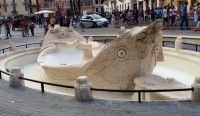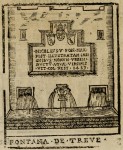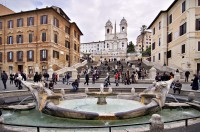 The Barcaccia fountain at the foot of the Spanish Steps in Rome’s Piazza di Spagna reopened to the public Monday after a 10-month restoration. The restoration cost 209,960 euro ($268,000) and was funded entirely by the sale of advertising space on site during eight months of the work. According to Paola Conti, technical director of Technicon, the firm contracted to restore the fountain, the most time-consuming aspect was removing the calcification that in just 15 years since the last restoration had grown up to a centimeter thick. They also had to remove biological organisms that thrive in the wet, light-filled environment. Old plaster from past repairs was replaced and finally the entire structure painted with a protective coating.
The Barcaccia fountain at the foot of the Spanish Steps in Rome’s Piazza di Spagna reopened to the public Monday after a 10-month restoration. The restoration cost 209,960 euro ($268,000) and was funded entirely by the sale of advertising space on site during eight months of the work. According to Paola Conti, technical director of Technicon, the firm contracted to restore the fountain, the most time-consuming aspect was removing the calcification that in just 15 years since the last restoration had grown up to a centimeter thick. They also had to remove biological organisms that thrive in the wet, light-filled environment. Old plaster from past repairs was replaced and finally the entire structure painted with a protective coating.
The fountain was built between 1627 and 1629 by Pietro Bernini, father of Gian Lorenzo Bernini whose architecture and sculpture would come to define Baroque Rome, in the shape of the low flat-bottomed river boats used to carry cargo across the Tiber in the 17th century. This was a very unusual approach in Mannerist Rome, more sculptural than architectural, a naturalistic, deceptively simple design that symbolized the fruitfulness and plenty of a boat low in the water, laden with bounty. Legend has it that during the devastating flood of Christmas 1598, the high waters, which reached a top mark of 20 meters above sea level, carried a boat all the way to the Piazza di Spagna. When the waters receded, the boat was stranded in the exact spot of the fountain. Ostensibly that’s why Bernini built the fountain in the shape of a boat 30 years later.
 Pope Urban VIII commissioned Pietro Bernini to build the fountain as part of a program envisioned by earlier popes that would place fountains in every major piazza in Rome. Urban also wanted to celebrate his restoration of the great Acqua Vergine aqueduct, originally built in 19 B.C. by Marcus Vipsanius Agrippa, Augustus’ son-in-law and right hand man. The pope had appointed the elder Bernini architect of the aqueduct in 1623, so having him build a new fountain to take advantage of the refreshed water source was a fitting bookend.
Pope Urban VIII commissioned Pietro Bernini to build the fountain as part of a program envisioned by earlier popes that would place fountains in every major piazza in Rome. Urban also wanted to celebrate his restoration of the great Acqua Vergine aqueduct, originally built in 19 B.C. by Marcus Vipsanius Agrippa, Augustus’ son-in-law and right hand man. The pope had appointed the elder Bernini architect of the aqueduct in 1623, so having him build a new fountain to take advantage of the refreshed water source was a fitting bookend.
The Acqua Vergine is unique among Rome’s aqueducts in that it was the only one that continued to work even in the devastated Medieval city through the Renaissance revival of public works. In the 14th century, when almost the entire city population was clustered on the malarial and flood-prone banks of the Tiber because they were bound by the range of the professional water carriers, only rione Trevi, the district at the foot of the Quirinal hill blessed with a fountain fed by the Acqua Vergine, had a significant population relatively distant from the Tiber. That Trevi fountain was not the one you see today with the giant statue of Oceanus guarding ever so many tourist coins. The current fountain was built in 1762. The Medieval one was a modest affair, a rectangle with three basins, enlarged in the 15th century to a wide trough fed by three spouts.
 The aqueduct was regularly maintained and repaired during the heyday of the Western Empire, but even after the Goths sacked the city in 537 A.D., specifically targeting the aqueducts, the Acqua Vergine kept trucking. This is mainly attributable to its nearby source and the predominance of underground tunnels. The water starts as rainfall in the Alban Hills, then filters through volcanic tuff before springing up in a town about eight miles east of Rome called Salone. The aqueduct starts at Salone, so it doesn’t have far to go to get to Rome, and since it was intended to water the lower-lying areas of the city, the pathways stay down low too. It was restored once in the 8th century by Pope Hadrian I and that seems to have kept it going until the 15th century when Pope Nicholas V commissioned a restoration project.
The aqueduct was regularly maintained and repaired during the heyday of the Western Empire, but even after the Goths sacked the city in 537 A.D., specifically targeting the aqueducts, the Acqua Vergine kept trucking. This is mainly attributable to its nearby source and the predominance of underground tunnels. The water starts as rainfall in the Alban Hills, then filters through volcanic tuff before springing up in a town about eight miles east of Rome called Salone. The aqueduct starts at Salone, so it doesn’t have far to go to get to Rome, and since it was intended to water the lower-lying areas of the city, the pathways stay down low too. It was restored once in the 8th century by Pope Hadrian I and that seems to have kept it going until the 15th century when Pope Nicholas V commissioned a restoration project.
There were always issues, mind you. It needed repair and cleaning on the regular to keep the water flowing, and the city magistrates passed all kinds of laws to keep people from tainting it by bathing their livestock and doing their laundry in the Trevi basin. Then there were all the individuals illegally tapping into the conduit to water their personal homes and gardens. A pope was one of the greatest offenders on that score: Pope Julius III, who swallowed up so much Acqua Vergine for his new home, the Villa Julia (built in 1553) and its elaborate grounds and entrance fountain, that by 1559 the Trevi fountain ran dry. To address the choked supply, in 1570 Pope Pius V had the Acqua Vergine restored all the way back to Salone. Urban VIII’s intervention in 1623 extended the path of the aqueduct to supply the growing city. It was this restoration that brought the water to the location of the current Fountain of Trevi.
 The Barcaccia played a more poignant historical role 200 years later. The poet John Keats lived the last few months of his life in a house on the Spanish Steps. So devastated by tuberculosis that he often cried upon waking to find himself still alive, Keats took comfort from the soothing sound of the Barcaccia’s flowing water. It made him think of a line from the Jacobean play Philaster by Francis Beaumont and John Fletcher: “As you are living, all your better deeds / Shall be in water writ.” Inspired by that line, Keats asked that his tombstone be inscribed solely “Here lies one whose name was writ in water,” no name, no date. When the tuberculosis finally claimed his life on February 23rd, 1821, his friend and carer Joseph Severn couldn’t quite bring himself to comply with Keats’ final wish. Instead, he took the opportunity to castigate the critics who had never appreciated Keats’ genius in life.
The Barcaccia played a more poignant historical role 200 years later. The poet John Keats lived the last few months of his life in a house on the Spanish Steps. So devastated by tuberculosis that he often cried upon waking to find himself still alive, Keats took comfort from the soothing sound of the Barcaccia’s flowing water. It made him think of a line from the Jacobean play Philaster by Francis Beaumont and John Fletcher: “As you are living, all your better deeds / Shall be in water writ.” Inspired by that line, Keats asked that his tombstone be inscribed solely “Here lies one whose name was writ in water,” no name, no date. When the tuberculosis finally claimed his life on February 23rd, 1821, his friend and carer Joseph Severn couldn’t quite bring himself to comply with Keats’ final wish. Instead, he took the opportunity to castigate the critics who had never appreciated Keats’ genius in life.
“This Grave / contains all that was Mortal / of a / Young English Poet / Who / on his Death Bed, in the Bitterness of his Heart / at the Malicious Power of his Enemies / Desired / these Words to be / engraven on his Tomb Stone: / Here lies One / Whose Name was writ in Water. 24 February 1821”
Although the fountain was inaccessible to visitors during the restoration, it and the conservators were visible thanks to an innovative plexiglass enclosure. Seeing is nice, but the Barcaccia is an interactive experience. It was specifically designed for people to drink from. The pure and delicious Acqua Vergine springs from jets at the bow and stern. Travertine platforms at each end of the boat give you a place to stand, albeit a rather damp place, so you can stretch out and quaff mightily from the water’s spouts. At Monday’s inauguration of the pristine fountain, the mayor of Rome Ignazio Marino, culture councillor Giovanna Marinelli and the Capitoline Superintendent Claudio Parisi Presicce were the first to drink from the newly reactivated water. They used a plastic cup, though, which is just wrong, in my opinion. They should have stretched out like the rest of us, sashes and suits be damned. Virgin Water in a plastic cup? I mean really.
You can see the fountain cleaned and the waters turned back on in this Italian news story about Monday’s inauguration:
[youtube=http://youtu.be/gEl9xx2NsI4&w=430]
I agree with you. I was on hand for this event and was quite annoyed. Why even bother to drink at all if you are going to ruin the ambiance of the community moment by using a cup. At east use a snazzy chalice if you are worried about slurping like the rest of us Roma minions.
Fascinating. I love this site…I have it on my RSS feed. Big thanks for giving us this.
Livius, wonderful story of a beautiful (and unique fountain. Thanks for the side stories that tell more about the place and the life around it. Above and beyond. (I agree that a plastic cup is pretty tacky. Under the circumstances, a Renaissance era chalice lifted high to the people might have been a nice touch, though…)
Destroyed on February 19, yesterday, at 4:30 (Rome time) by Feyenoord fans, while waiting for a soccer match vs Rome Team: http://www.ansa.it/english/news/2015/02/19/feyenoord-fans-damage-barcaccia-fountain-update_ac563070-1be5-4cb7-8473-c46351759703.html … The Muses today are so sad.